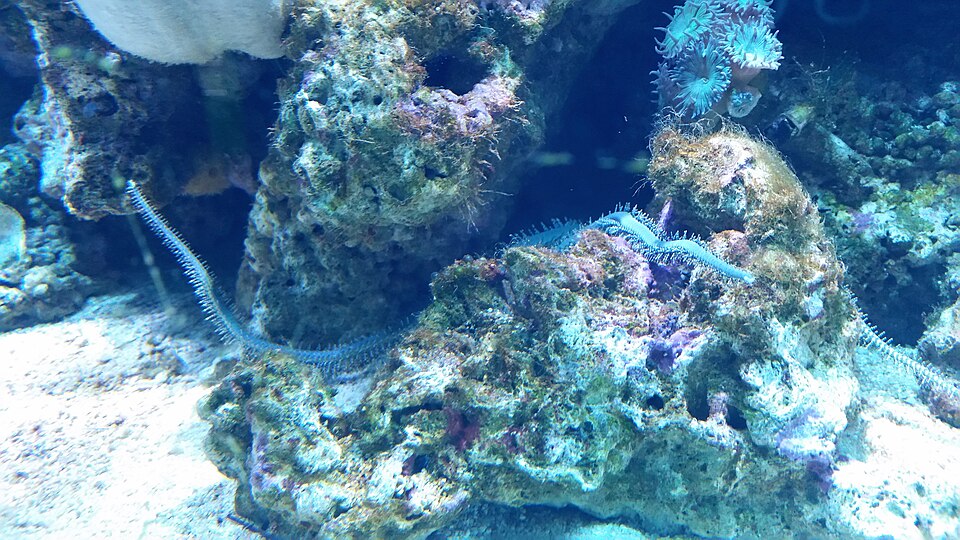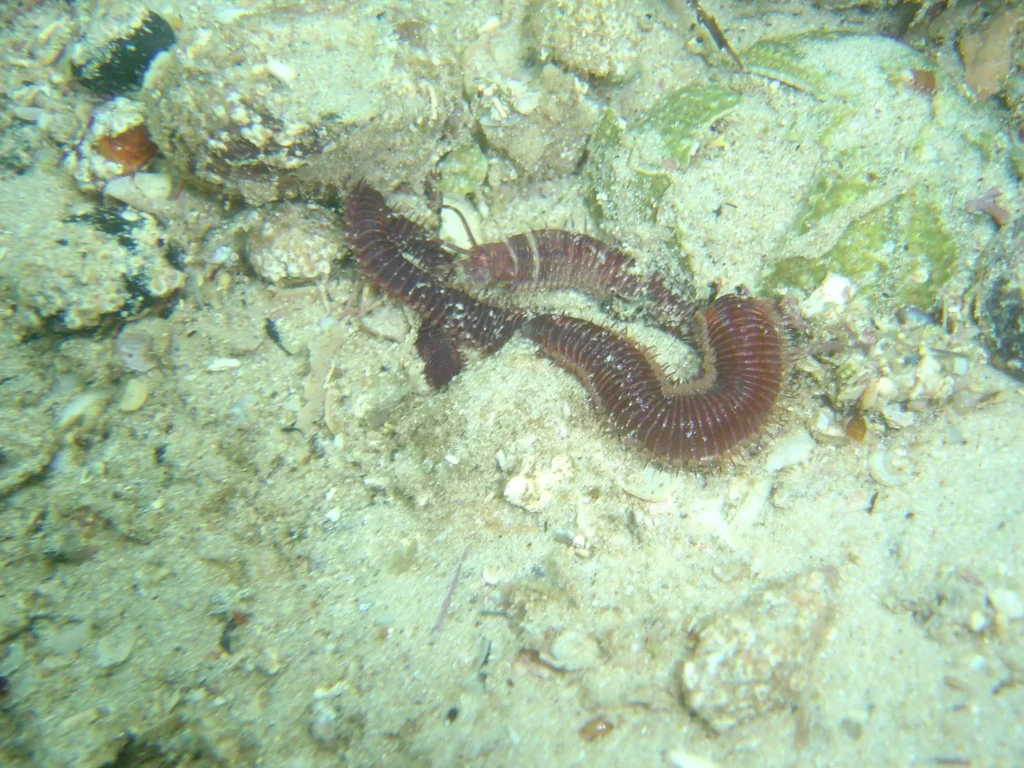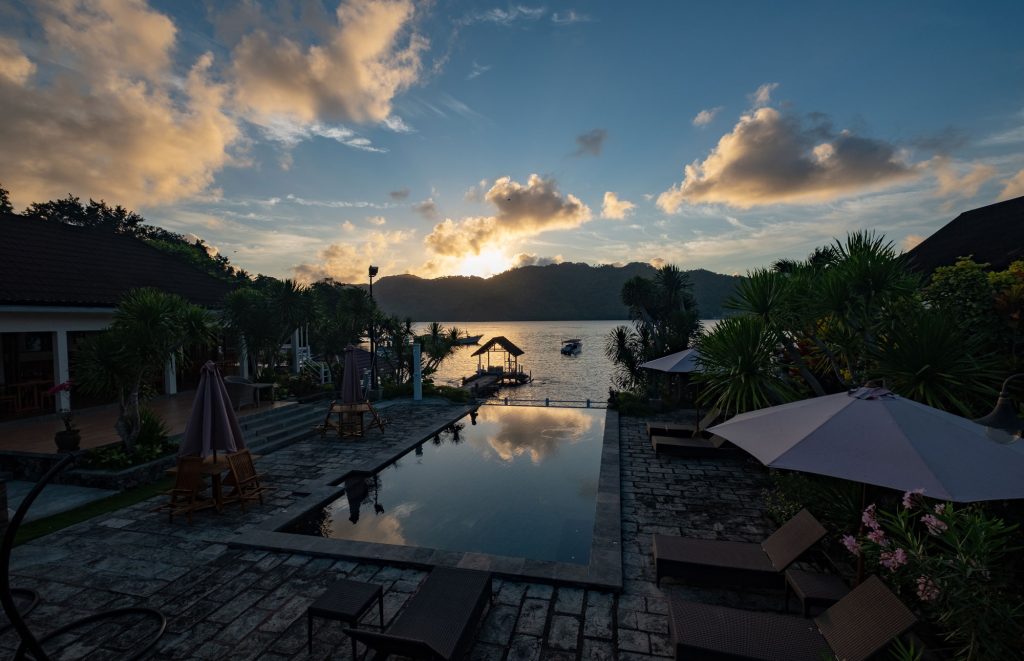If you’re diving in Lembeh at night, keep an eye on the sand. You might spot five antennae waving from a small hole. That’s your clue, a bobbit worm is waiting. When a fish swims too close, it strikes fast and its jaws snap shut like scissors. It’s one of Lembeh’s most unique hunters. But what exactly is a bobbit worm?
What is a Bobbit Worm?

The bobbit worm (Eunice aphroditois) is a predatory marine worm known for its ambush hunting style, sharp jaws, and iridescent body, commonly found in tropical muck diving locations like Lembeh Strait. The bobbit worm can grow to over one meter in length.
Its body is iridescent and segmented. On top of its head are five antennae used to sense prey. Not only that, it also has a powerful jaw that can snap in half small crustaceans and other marine life, making it a formidable ambush predator.
Why Is It Called the Bobbit Worm?
The name “bobbit worm” comes from the Lorena and John Bobbitt case in the early 1990s. It was a widely publicized incident where Lorena, to say the least, attacked her husband with a knife. Around the same time, researchers studying this worm noted how it strikes fast and slices prey with sharp jaws. This striking similarity gave rise to the nickname. While not scientific, the name stuck with everyone.
The Life and Habits of the Bobbit Worm
Planning to see a bobbit worm on your next dive? Let’s start by learning where it lives and how it hunts. Understanding its behavior will help you find one and know what to expect when you do find one.
Where Do Bobbit Worms Live?
Bobbit worms are found in warm tropical waters across the Indo-Pacific. They prefer sandy or silty seabeds, especially areas with soft sediment, rubble, or debris. You’ll often find them near coral outcrops or reef slopes where prey is abundant.
During the day, they stay buried deep with only their head and antennae exposed. At night, they become active, waiting to ambush passing prey. They could usually be seen between 10 and 40 meters deep, though they’ve been found deeper.
Related reads: Night Diving Adventures: Discovering Nocturnal Marine Life.
Hunting Techniques and Diet
The bobbit worm is a “sit-and-wait” predator. It buries its entire body, which can reach up to three meters in length, in the sediment. The worm then waits for prey to swim by. When a fish or crustacean gets close, the bobbit worm launches its head out of the sand with incredible speed. Its sharp, muscular jaws, called mandibles, can seize and often cut the prey in half. The worm then drags the prey into its burrow to be consumed.
Life Cycle and Reproduction
Bobbit worms reproduce by releasing eggs and sperm into the water at night. The fertilized eggs hatch into tiny larvae that drift with the current until they settle on the seabed. From there, they grow into full-sized worms. What makes them even more unique is their ability to regenerate. If injured, a bobbit worm can regrow lost limbs, including its jaws and even its head!
Is Bobbit Worm Dangerous?

No, but you should still try to keep your distance. It doesn’t seek out contact with divers and spends most of its time hidden in the sand. Its bristles are venomous, and its jaws are sharp, so close interaction isn’t recommended. As with many marine animals, the best experience comes from observing respectfully at a safe distance.
You might also like: Diver Safety: Are You Truly Prepared?
Bobbit Worm Photography: Tips for the Perfect Shot
Photographing a bobbit worm takes patience and preparation. Its bold colors and dramatic strike make it a favorite among macro photographers. But its ambush style means you’ll need to plan your shot before it moves. Once in position, the worm won’t wait long.
How to photograph a Bobbit Worm in Lembeh:
- Dive at night when the worm is active and hunting.
- Use a strong focus light to help your camera lock focus in low light.
- Position strobes carefully to light both the worm and its surroundings.
- Choose a fast shutter speed to freeze motion during the strike.
- A 60mm or 100mm macro lens works best for sharp close-up detail.
- Move slowly and stay low to avoid startling the worm.
Learning the worm’s behavior helps you prepare for the shot. Look for five antennae sticking out of the sand. The worm may shift slightly or wiggle its feelers before a strike. When you see this, it’s time to shoot. Keep your position steady and your strobes ready. The action is fast and over in seconds.
Why Lembeh Strait is a Hotspot for Bobbit Worm Sightings
Lembeh Strait has everything the bobbit worm needs. The black sand is soft, silty, full of rubble, and it’s easy to burrow into. The area is rich in small fish and crustaceans, which makes it ideal for hunting. That’s why sightings here are more common than in most places. Plan your route while diving in Lembeh to each site so you can be better prepared when meeting these sea creatures.
When diving with Solitude Lembeh, you don’t need to plan out your routes as our guides know these dive sites well. They understand where bobbit worms live and how they behave. With their help, you’ll spend less time searching and more time watching the worm do what it does best.
Other Unique Critters You’ll Find While Diving in Lembeh
Lembeh is a mecca for unique marine life. Here are other extraordinary critters you can find:
- Flamboyant Cuttlefish: A small cuttlefish that walks on its arms and flashes bright colors when threatened or hunting.
- Weedy Scorpionfish: Often buried in sand with only their eyes showing, these ambush predators are easy to miss.
- Mimic Octopus: Famous for imitating other sea creatures, like lionfish, flatfish, or sea snakes, to confuse predators.
- Ornate Ghost Pipefish: Delicate and well-camouflaged, they often float near crinoids or algae to blend in perfectly.
- Wunderpus Octopus: A close relative of the mimic octopus, known for its brown and white patterns and display arms.
- Mandarinfish: Small, brightly patterned fish that perform a quick mating dance around dusk near coral rubble.
Continue reading: Lembeh Critters: The Best Guide to Muck Diving in Lembeh Strait
Want to Spot a Bobbit Worm Yourself?

Few marine creatures are as unique or fascinating as the bobbit worm. From its hidden hunting style to its razor-sharp jaws and impressive regeneration, this predator offers one of the most unique sightings in muck diving. Now you know where it lives, how it hunts, and what to watch for. With the right timing and a bit of patience, you’ll be ready when you encounter it while diving.
At Solitude Lembeh Resort, every dive is supported by experienced, PADI-certified guides who know exactly where and how to look for the bobbit worm. They make your night dive smooth, focused, and rewarding. And when the dive is done, your villa is waiting. You’ll return to quiet comfort, rinse off the salt, and enjoy a warm, home-cooked meal prepared for you on-site.
Book your next adventure with Solitude Lembeh and bring your macro wish list to life!